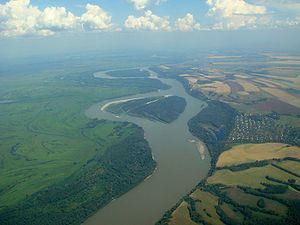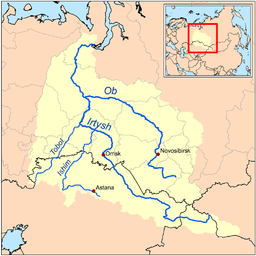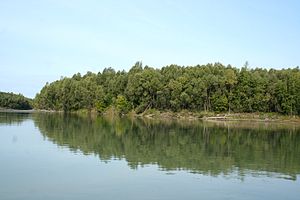- Ob River
-
For other uses, see Ob (disambiguation).
Ob (Обь) Obi River Near BarnaulCountry Russia Regions Altai Krai, Novosibirsk Oblast, Tomsk Oblast, Khantia-Mansia, Yamalia Tributaries - left Katun River, Anuy River, Charysh River, Aley River, Parabel River, Vasyugan River, Irtysh River, Northern Sosva River - right Biya River, Berd River, Inya River, Tom River, Chulym River, Ket River, Tym River, Vakh River, Pim River, Kazim River Cities Biysk, Barnaul, Novosibirsk, Nizhnevartosk, Surgut Primary source Katun River - location Belukha Mountain, Altai Republic - elevation 2,300 m (7,546 ft) - coordinates 49°44′40″N 86°39′41″E / 49.74444°N 86.66139°E Secondary source Biya River - location Lake Teletskoye, Altai Republic - elevation 434 m (1,424 ft) - coordinates 51°47′11″N 87°14′49″E / 51.78639°N 87.24694°E Source confluence Near Biysk - elevation 195 m (640 ft) - coordinates 52°25′54″N 85°01′26″E / 52.43167°N 85.02389°E Mouth Gulf of Ob - location Ob Delta, Yamalia - elevation 0 m (0 ft) - coordinates 66°32′02″N 71°23′41″E / 66.53389°N 71.39472°E Length 2,962 km (1,841 mi) Basin 2,972,497 km2 (1,147,688 sq mi) Discharge for Salekhard - average 12,475 m3/s (440,550 cu ft/s) [1] - max 40,200 m3/s (1,419,650 cu ft/s) - min 2,360 m3/s (83,343 cu ft/s) The Ob River (Russian: Обь), also Obi, is a major river in western Siberia, Russia and is the world's seventh longest river. It is the westernmost of the three great Siberian rivers that flow into the Arctic Ocean (the other two being the Lena River and the Yenisei River). The Gulf of Ob is the world's longest estuary.
Contents
Names
The Ob is known to the Khanty people as the As, Yag, Kolta and Yema; to the Nenets people as the Kolta or Kuay; and to the Siberian Tatars as the Umar or Omass.
Geography
The Ob forms 16 miles (26 km) southwest of Biysk in Altai Krai at the confluence of the Biya and Katun rivers. Both these streams have their origin in the Altay Mountains, the Biya issuing from Lake Teletskoye, the Katun, 700 kilometres (430 mi) long, bursting out of a glacier on Mount Byelukha.
The river splits into more than one arm, especially after joining the large Irtysh tributary at about 69° E. (Originating in China, the Irtysh is actually longer than the Ob from source to the point of their confluence.) From the source of the Irtysh to the mouth of the Ob, the river flow is the longest in Russia at 5,410 kilometres (3,360 mi). Other noteworthy tributaries are: from the east, the Tom, Chulym, Ket, Tym and Vakh rivers; and, from the west and south, the Vasyugan, Irtysh (with the Ishim and Tobol rivers), and Sosva rivers.
The Ob zigzags west and north until it reaches 55° N, where it curves round to the northwest, and again north, wheeling finally eastwards into the Gulf of Ob, a 600-mile (970 km)-long bay of the Kara Sea, separating the Yamal Peninsula from the Gydan Peninsula.
The combined Ob-Irtysh system, the third-longest river system of Asia (after China's Yangtze and Yellow rivers), is 5,410 kilometres (3,360 mi) long, and the area of its basin 2,990,000 square kilometres (1,150,000 sq mi). The river basin of the Ob consists mostly of steppe, taiga, swamps, tundra, and semi-desert topography. The floodplains of the Ob are characterized by many tributaries and lakes. The Ob is ice-bound at southern Barnaul from early in November to near the end of April, and at northern Salekhard, 100 miles (160 km) above its mouth, from the end of October to the beginning of June. The Ob River crosses several climatic zones. The upper Ob valley, in the south, grows grapes, melons and watermelons, whereas the lower reaches of the Ob are Arctic tundra. The most comfortable climate for the rest on the Ob - are Biisk, Barnaul and Novosibirsk.
Human use
The Ob is used mostly for irrigation, drinking water, hydroelectric energy, and fishing; the river has more than 50 species of fish.
The navigable waters within the Ob basin reach a total length of 9,300 miles (15,000 km). The importance of the Ob basin navigation for transportation was particularly great before the completion of the Trans-Siberian Railway, since, despite the general south-to-north direction of the flow of Ob and most of its tributaries, the width of the Ob basin provided for (somewhat indirect) transportation in the east-west direction as well. Until the early 20th century, a particularly important western river port was Tyumen, located on the Tura River, a tributary of the Tobol. Reached by an extension of the Ekaterinburg-Perm railway in 1885, and thus obtaining a rail link to the Kama and Volga rivers in the heart of Russia, Tyumen became an important railhead for some years until the railway was extended further east. In the eastern reaches of the Ob basin, Tomsk on the Tom River was an important terminus.
Tyumen had its first steamboat in 1836, and the middle reaches of the Ob have been navigated by steamboats since 1845. The first steamboat on the Ob, Nikita Myasnikov's "Osnova", was launched in 1844; but the early starts were difficult, and it was not until 1857 that steamboat shipping started developing in the Ob system in the serious way. Steamboats started operating on the Yenisei in 1863, on the Lena and Amur in the 1870s. In an attempt to extend the Ob navigable system even further, a system of canals, utilizing the Ket River, 560 miles (900 km) long in all, was built in the late 19th century to connect the Ob with the Yenisei, but soon abandoned as being uncompetitive with the railway.
The Trans-Siberian Railway, once completed, provided for more direct, year-round transportation in the east-west direction. But the Ob river system still remained important for connecting the huge expanses of Tyumen Oblast and Tomsk Oblast with the major cities along the Trans-Siberian route, such as Novosibirsk or Omsk. In the second half of the 20th century, construction of rail links to Labytnangi, Tobolsk, and the oil and gas cities of Surgut, and Nizhnevartovsk provided more railheads, but did not diminish the importance of the waterways for reaching places still not served by the rail.
A dam was built near Novosibirsk in 1956, which created the then-largest artificial lake in Siberia, called Novosibirsk Reservoir.
In the 1960s through 1980s, a gigantic project was contemplated by Soviet engineers and administrators to divert some of the waters of Ob and Irtysh to Kazakhstan and Soviet Central Asian republics, replenishing the Aral Sea as well. The project never left the drawing board, abandoned in 1986 due to economic and environmental considerations.[2] [3]
Pollution
In the early years of operation, the Mayak plant released vast quantities of radioactively contaminated water into several small lakes near the plant. These lakes drain into the Techa River, whose waters ultimately flow into the Ob River.
Tributaries
The Irtysh is the major tributary of the Ob. The larger tributaries along its course are:
from the West from the East - Peschanaya
- Anuy River
- Charysh River
- Aley River
- Barnaulka
- Kasmala
- Shegarka
- Chaya River
- Parabel River
- Vasyugan River
- Yugan River
- Salym River
- Irtysh
- Sosva River
- Schuchya
- Synya River
- Chumysh River
- Berd River
- Inya River
- Tom River
- Chulym River
- Ket River
- Tym River
- Kievsky Egan
- Vakh River
- Vatinsky Egan
- Tromyogan River
- Pim River
- Lyamin River
- Kazim River
- Polui River
In addition, the Nadym River and the Pur River flow into the Gulf of Ob and the Taz River into the Taz Estuary, a side arm of the Gulf of Ob.
Cities along the Ob
Cities along the river include:
- Barnaul
- Novosibirsk (Russia's third largest city)
- Kolpashevo
- Nizhnevartovsk
- Surgut
- Khanty-Mansiysk
- Beryozovo
- Labytnangi
- Salekhard
See also
- Rivers of Russia
References
- ^ "Ob River at Salekhard". River Discharge Database. Center for Sustainability and the Global Environment. 1930-present. http://www.sage.wisc.edu/riverdata/scripts/station_table.php?qual=32&filenum=1693. Retrieved 2010-11-06.
- ^ Douglas R. Weiner, "A Little Corner of Freedom: Russian Nature Protection from Stalin to Gorbachev". University of California Press, 1999. ISBN 0520232135. On Google Books p. 415 (English)
- ^ Michael H. Glantz, "Creeping Environmental Problems and Sustainable Development in the Aral Sea...". ISBN 0521620864. On Google Books p. 174
 This article incorporates text from a publication now in the public domain: Chisholm, Hugh, ed (1911). Encyclopædia Britannica (11th ed.). Cambridge University Press.
This article incorporates text from a publication now in the public domain: Chisholm, Hugh, ed (1911). Encyclopædia Britannica (11th ed.). Cambridge University Press.
External links
Categories:- Ob basin
- Rivers of Altai Krai
- Rivers of Khanty-Mansi Autonomous Okrug
- Rivers of Novosibirsk Oblast
- Rivers of Tomsk Oblast
- Rivers of Yamalo-Nenets Autonomous Okrug
- Drainage basins of the Kara Sea
Wikimedia Foundation. 2010.




